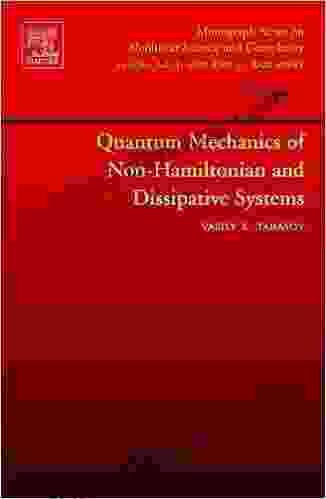Quantum Mechanics of Non-Hamiltonian and Dissipative Systems: A Comprehensive Guide to the Cutting Edge of Quantum Physics

Quantum mechanics is the fundamental theory of nature at the atomic and subatomic level. It describes the behavior of particles such as electrons, protons, and atoms, and the interactions between them. The traditional formulation of quantum mechanics, known as Hamiltonian mechanics, assumes that the system under study is isolated from its environment and that it evolves in a deterministic manner. However, in many real-world situations, these assumptions are not valid. The system may be coupled to its environment, leading to dissipation of energy and the emergence of non-Hamiltonian dynamics. In this article, we will explore the fascinating world of non-Hamiltonian and dissipative quantum systems.
Non-Hamiltonian Systems
Non-Hamiltonian systems are quantum systems that do not obey the laws of Hamiltonian mechanics. This means that their evolution cannot be described by a Hamiltonian, which is a function that determines the system's energy and dynamics. There are many different types of non-Hamiltonian systems, including:
4.4 out of 5
| Language | : | English |
| File size | : | 3766 KB |
| Text-to-Speech | : | Enabled |
| Screen Reader | : | Supported |
| Print length | : | 530 pages |
- Open quantum systems: These are systems that are coupled to their environment and exchange energy and information with it. Open quantum systems are ubiquitous in nature and play a key role in many important phenomena, such as photosynthesis and chemical reactions.
- Dissipative quantum systems: These are systems that lose energy to their environment over time. Dissipation is a fundamental process that occurs in all real-world systems, and it can have a profound impact on the system's dynamics.
- Non-Markovian quantum systems: These are systems whose dynamics depends on their history. In other words, the state of a non-Markovian system at a given time depends not only on its state at the previous time, but also on its entire history. Non-Markovian systems are found in a wide range of applications, such as quantum computing and quantum metrology.
Dissipative Systems
Dissipative quantum systems are quantum systems that lose energy to their environment. Dissipation is a fundamental process that occurs in all real-world systems, and it can have a profound impact on the system's dynamics. In particular, dissipation can lead to the emergence of non-Hamiltonian behavior, such as:
- Non-equilibrium steady states: These are states that are not in equilibrium with the system's environment. Non-equilibrium steady states are often found in open quantum systems that are driven by an external force.
- Quantum phase transitions: These are transitions between different phases of matter, such as from a superconductor to an insulator. Quantum phase transitions can be driven by dissipation, and they can lead to the emergence of new quantum phenomena.
- Quantum chaos: This is a regime of quantum dynamics that is characterized by the exponential growth of small perturbations. Quantum chaos is found in a wide range of systems, including atomic nuclei and black holes.
Applications of Non-Hamiltonian and Dissipative Systems
Non-Hamiltonian and dissipative quantum systems have a wide range of applications in science and technology. Some of the most important applications include:
- Quantum computing: Quantum computers are devices that use quantum mechanics to perform computations. Non-Hamiltonian and dissipative systems are being explored as a way to build more efficient and powerful quantum computers.
- Quantum metrology: Quantum metrology is the use of quantum mechanics to make precise measurements. Non-Hamiltonian and dissipative systems are being used to develop new quantum sensors that are more sensitive and accurate than classical sensors.
- Quantum thermodynamics: Quantum thermodynamics is the study of the relationship between quantum mechanics and thermodynamics. Non-Hamiltonian and dissipative systems are being used to explore the foundations of quantum thermodynamics and to develop new ways to control and manipulate energy.
Non-Hamiltonian and dissipative quantum systems are a fascinating and rapidly growing field of research. These systems offer a new way to understand the fundamental laws of nature and to develop new technologies. As we continue to explore the world of non-Hamiltonian and dissipative systems, we can expect to uncover many new and exciting discoveries.
For more information on this topic, please refer to the following resources:
- Quantum Mechanics of Non-Hamiltonian and Dissipative Systems
- Quantum Mechanics of Non-Hamiltonian and Dissipative Systems
- Quantum Mechanics of Non-Hamiltonian and Dissipative Systems
4.4 out of 5
| Language | : | English |
| File size | : | 3766 KB |
| Text-to-Speech | : | Enabled |
| Screen Reader | : | Supported |
| Print length | : | 530 pages |
Do you want to contribute by writing guest posts on this blog?
Please contact us and send us a resume of previous articles that you have written.
 Book
Book Novel
Novel Page
Page Chapter
Chapter Text
Text Story
Story Genre
Genre Reader
Reader Library
Library Paperback
Paperback E-book
E-book Magazine
Magazine Newspaper
Newspaper Paragraph
Paragraph Sentence
Sentence Bookmark
Bookmark Shelf
Shelf Glossary
Glossary Bibliography
Bibliography Foreword
Foreword Preface
Preface Synopsis
Synopsis Annotation
Annotation Footnote
Footnote Manuscript
Manuscript Scroll
Scroll Codex
Codex Tome
Tome Bestseller
Bestseller Classics
Classics Library card
Library card Narrative
Narrative Biography
Biography Autobiography
Autobiography Memoir
Memoir Reference
Reference Encyclopedia
Encyclopedia Brian Lovett
Brian Lovett Brian Lawrenson
Brian Lawrenson Brendan Bowers
Brendan Bowers Edward Couzens Lake
Edward Couzens Lake John Scally
John Scally Bob Vorwald
Bob Vorwald Bob Robb
Bob Robb Brenda Jackson
Brenda Jackson Brian Burns
Brian Burns Brian Godawa
Brian Godawa Bojana Cvejic
Bojana Cvejic Bulent Atalay
Bulent Atalay Janette Rallison
Janette Rallison Bryan Mackay
Bryan Mackay Wolf Dieter Roth
Wolf Dieter Roth Bruce J West
Bruce J West Sam Herting
Sam Herting Cecilia Minden
Cecilia Minden Bridget Owusu
Bridget Owusu Bonnie Williams
Bonnie Williams
Light bulbAdvertise smarter! Our strategic ad space ensures maximum exposure. Reserve your spot today!

 Clarence MitchellBreak Free from Solo Travel Anxiety: A Comprehensive Guide to Embracing the...
Clarence MitchellBreak Free from Solo Travel Anxiety: A Comprehensive Guide to Embracing the... Branson CarterFollow ·13.1k
Branson CarterFollow ·13.1k Ethan MitchellFollow ·4k
Ethan MitchellFollow ·4k Dawson ReedFollow ·19.8k
Dawson ReedFollow ·19.8k Yukio MishimaFollow ·17.1k
Yukio MishimaFollow ·17.1k Nikolai GogolFollow ·6.1k
Nikolai GogolFollow ·6.1k Norman ButlerFollow ·12.3k
Norman ButlerFollow ·12.3k Heath PowellFollow ·3.8k
Heath PowellFollow ·3.8k Lee SimmonsFollow ·6.9k
Lee SimmonsFollow ·6.9k

 Colin Richardson
Colin Richardson12 Pro Wrestling Rules for Life: Unlocking Success and...
Step into the squared circle of life with...

 Banana Yoshimoto
Banana YoshimotoUnveiling the Haunting Depths of "The Bunker Diary" by...
In the realm of...

 Braden Ward
Braden WardYouth Basketball Drills by Burrall Paye: Unleashing the...
In the realm of basketball,...

 Zadie Smith
Zadie SmithUnveiling the Frontiers of Public Policy and Governance:...
In an era characterized by rapid...
4.4 out of 5
| Language | : | English |
| File size | : | 3766 KB |
| Text-to-Speech | : | Enabled |
| Screen Reader | : | Supported |
| Print length | : | 530 pages |














